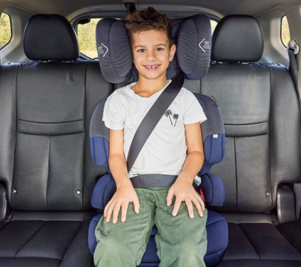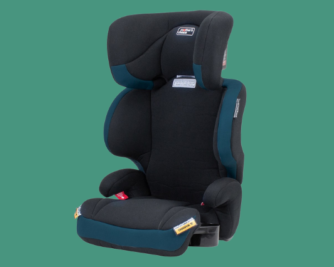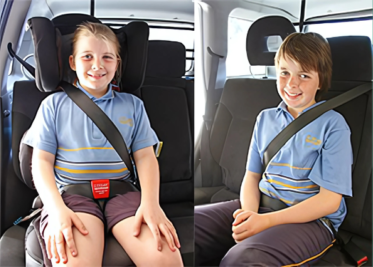Facebook-f
Youtube
Linkedin-in
Moving out of a booster seat too early?
Did you know...
A study in 2018 found that children using seat belts instead of a booster seat had 5 times higher risk of injuries in car crashes.
There are common misconceptions regarding when children should transition out of their booster seats and into an adult seat belt and this resource helps parents and children navigate this together.
In a crash, seat belts can cause severe injuries if not properly positioned. Booster seats minimize this risk by accounting for a child’s smaller stature and developmental needs.
Front airbags kill children
Did you know most vehicle manufacturers state that a child under 12 years of age should never sit in the front seat of their vehicles. The back seat is non-negotiable for children under 12. Sitting in the front seat exposes them to significant dangers, particularly from front airbags, which are designed to protect adults but can cause severe injury or even death to small children in the event of a crash. The force of an airbag deploying is immense and can be deadly for a child’s fragile body. Don’t gamble with their lives; it’s a choice that could mean the difference between life and death.



Is your child 145 cm tall? then you need to check the 3b's!

BODY
Can your child sit with their back against the seat and their knees bent over the edge of the seat base?

BELT
Is the lap belt on their hips and the sash sitting nicely on their shoulder?

BEHAVIOuR
*Always use your child seat to it’s MAXIMUM limits, for your child’s sake.
Many children don’t grow out of their current booster until 11 or 12 years old. Always use your current child seat to its maximum limits before progressing
The Dangers of Moving Out of a Booster Too Soon
Transitioning children out of booster seats prematurely can result in:
• Internal injuries during crashes due to seatbelts pressing against the stomach or neck.
• Greater likelihood of ejection from the seat during a collision.
• Misalignment of the seatbelt, reducing its effectiveness.
According to Australian road safety studies, improper seatbelt use is a leading cause of preventable injuries among children aged 8-12.
FAQS
IMPORTANCE OF BOOSTER SEATS
When can my child safely transition out of a booster seat?
Easy! If you're child is over 7 years old and is 145cms tall then you'll need to check the 3B's:
BODY: Can Your Child Sit Correctly on the Vehicle’s Seat?
With their back against the seat and their knees bent over the edge of the seat base
BELT: Does the Seat Belt Fit Your Child Correctly?
Is the lap on their hips and the sash nicely on their shoulder?
BEHAVIOR: Can Your Child Stay in This Position for the Entire Trip?
REMEMBER: Always use your child seat to it's maximum limits before moving your child on to the next stage
What are the height guidelines?
• Children under 145 cm should remain in a booster seat to ensure seat belt effectiveness. Children over 145cms tall need to use the 3B's to help prevent serious injury. Not all vehicles are the same in Australia so please check your child's compatibility with your vehicle to ensure safe travel guidelines are met.
Are Booster seats mandatory for children over 7 in Australia?
• While the law mandates proper restraints until 7, experts recommend booster seats until at least 11-12 years, depending on the child’s height.
Can i use a second-hand booster seat?
• Yes, while it's not recommended there is no law against using a second hand child seat. You must ensure it hasn’t been in a crash, each component is still operating as it was when the unit was brand new, there are no visible signs of wear or damage, is under 10 years old, and meets Australian Standards (look for the AS/NZS 1754 label).
What about Child Restraint Laws?
Our National Road Rules state the following concerning booster age children;
• Children up to 7 years must use an approved child restraint (car seat or booster seat) suitable for their size and age.
• From 7-12 years, children must use a booster seat or seat belt adjusted to fit properly, based on their height.
What does a booster seat actually do?
• Booster seats position the seat belt correctly across the child’s chest and pelvis, reducing the chance of abdominal or spinal injuries during a crash.
• Research indicates children often reach a suitable height for adult seat belts at around 11-12 years, depending on their growth.
• In a crash, seat belts can cause severe injuries if not properly positioned.
• Booster seats minimize this risk by accounting for a child’s smaller stature and developmental needs.
Statistics
• Properly used child restraints reduce the risk of serious injury by up to 70%.
• A 2018 study by Austroads found that children using seat belts instead of booster seats had 5 times higher risks of injuries in car crashes.
When can a child sit in the front seat?
Most vehicle manufacturers state that a child under 12 years of age should never sit in the front seat of their vehicles. The back seat is non-negotiable for children under 12. Sitting in the front seat exposes them to significant dangers, particularly from front airbags, which are designed to protect adults but can cause severe injury or even death to small children in the event of a crash. The force of an airbag deploying is immense and can be deadly for a child’s fragile body. Moreover, children lack the size and strength to withstand the impact forces that adult occupants might endure. Prioritizing your child's safety means making the tough decision to keep them securely buckled in the back seat until they are old enough and big enough to sit upfront safely. Don’t gamble with their lives; it’s a choice that could mean the difference between life and death.
